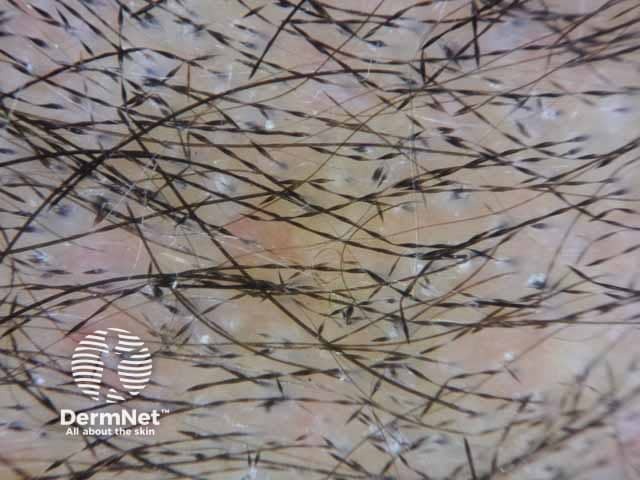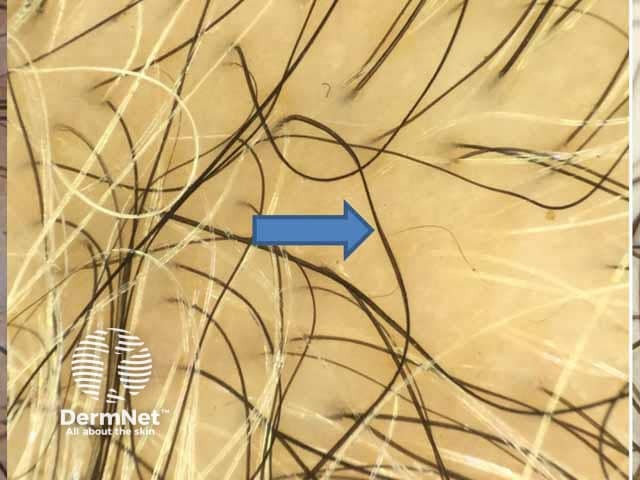Main menu
Common skin conditions

NEWS
Join DermNet PRO
Read more
Quick links
Author: Dr Ahmed Sadek, Dermatologist, Cairo Hospital for Dermatology & Venereology (Al-Haud Al-Marsoud), Egypt (2022)
Contributors: Dr Dalia Hossam, Dr Radwa Magdy, Dr Nehal Saied, Dr Noha Hashem, Dr Safaa Yehia Negm, Dr Moshera Saied El Bahrawy, Dr Amira Ragab, Dr Amal Wagih, Dr Haidy El-Hussieny, Dr Mona Ragib, Dr Hala Amer (2022)
Edited by the DermNet content department
Introduction
Structural hair shaft defects associated with hair fragility
Monilethrix
Monilethrix-like hairs
Trichorrhexis invaginata (bamboo hair)
Trichorrhexis nodosa
Pili torti
Trichothiodystrophy
Structural hair abnormalities not associated with hair fragility
Woolly hair
This page covers the diagnosis of different structural genetic hair shaft defects. These are classified based on their association with hair fragility.
The term is derived from the Greek meaning “necklace” or “beaded”. Monilethrix is an autosomal dominant disorder that usually affects individuals in the first few months after birth. Affected hairs appear short, fragile, and brittle. The disorder mainly affects the scalp, however, in severe cases it may involve eyebrows, eyelashes, and nails (koilonychia).

Monilethrix presenting with constrictions regularly arranged along the hair shaft (DHS-patient1)
Monilethrix-like hairs show the same constrictions but without the regular distribution characteristic of true monilethrix. It occurs in monilethrix-like congenital hypotrichosis, alopecia areata, lichen planopilaris and patients receiving chemotherapy.
An abnormality of the hair in which the hair shaft invaginates into itself at multiple points along the shaft. The disorder becomes evident at infancy. Affected hairs are short, sparse, and very fragile. It is pathognomonic for Netherton syndrome. Recently, matchstick hairs were also described in Netherton syndrome as short hairs with a bulging end.
The most common structural hair shaft abnormality caused by damage of the hair shaft cuticle. Causes:
The trichoscopic features of trichorrhexis nodosa depend on the magnification used and the presence of immersion fluid (Fig 50).

Brush-like small fibers at the distal end of the hair shaft (red circles) denoting trichorrhexis nodosa in a female patient (DHS-patient2)
Pili torti is a structural hair shaft defect which is associated with multiple disorders.
Conditions associated with pili torti:
Affected hair shafts show flattening with twisting of the hair fiber three to ten twists on its long axis. This abnormality is best observed by dry dermoscopy at high magnification.

Pili torti; flattened and twisted hairs on their own axis
It is an autosomal recessive disorder characterised by sulfur-deficient hair. This disorder is mainly diagnosed using polarized light microscopy as it shows alternating bright and dark bands along the hair shaft, resembling a tiger’s tail.
Trichoscopic examination is of limited value in diagnosing the disorder; it shows heterogeneous hair shafts resembling grains of sand with slightly wavy contour.
Pili annulati is characterized by multiple air-filled cavities along the hair shaft. The disorder is detected in blonde hair much more easily than in darkly pigmented hair.
Alternating dark and light bands along the hair shaft corresponding to the air-filled cavities.
Hutchinson et al. classified the condition into three variants:
This disorder is characterised by tightly curled hair shafts with 180° longitudinal twisting, giving the appearance of a crawling snake. Common associations:
See Trichoscopy: an overview for more images on trichoscopic findings.